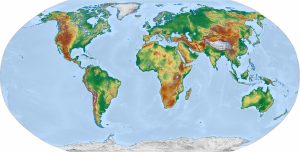Recently many people have been making a statement about cleaning up our oceans and climate change. They talk about all of these different concepts: ocean warming, ocean acidification, overfishing, pollution, and coral bleaching. They tell us the oceans are in grave danger. All of these terms sound intimidating but what do they mean? More importantly, why should it matter to you?

Physical Map of the World under CC 4.0
Looking at a map you can tell that the ocean takes up the majority of our planets surface area, and when calculated it covers 72% of the earths surface. The ocean also provides over 50% of the earth’s oxygen and stores 50 times more carbon dioxide than the atmosphere. It also plays a large role in regulating our planet’s climate and weather patterns. If you want to read a little more about all of this check this article out.
If all of that doesn’t convince you of the importance of the ocean, think about how involved people are with the ocean and the beach. There’s swimming, surfing, boating, parasailing, cruises, the list goes on and on.
The ocean also plays a pretty big part of the economics of the world. You also may not realize how important the ocean is for coastal communities in developing countries. For example just in the United States the ocean facilitates about 282 million dollars per year and creates about 3 million jobs. It also provides a mode for 90% of all trade transportation in the world. Lastly, we use the ocean for a large portion of our protein source.

People swimming and diving in the water by GoodFreePhotos CC by 2.0
The biodiversity of oceans is critical. Coral reefs (a tropical marine ecosystem) are often considered the “tropical rainforest of the sea“ due to their diversity in marine life and varying animal species. There is still a lot to discover about the ocean, however we do know it’s important to maintain because it’s the largest ecosystem we have on the planet. This ecosystem maintains homeostasis via regulation by abiotic and biotic factors. The oceans are often overlooked especially since we don’t see the dynamics between marine organisms and our own environment as we don’t share this habitat.
In tropical marine ecosystems, biotic factors include sea plants, algae, bacteria, and animals. Abiotic factors are similar to those on land such as sunlight, temperature, and soil nutrients. However, since the ocean is water, pH and salinity are also considered important abiotic factors that influence and sustain healthy and productive organisms. Oceans function just like land ecosystems, but they have far more area and depth. Both aquatic and terrestrial ecosystems have complicated food webs that distribute energy, and the main biotic components are a variety of primary producers, consumers and decomposers. Marine food webs contain primary producers such as phytoplankton which undergo photosynthesis and provide consumers with the nutrients they need. Click here for a video from Khan Academy to learn more about about food chains and trophic levels. Trophic pyramids for aquatic ecosystems are inverted compared to terrestrial ecosystems due to the fact that the short life span and rapid consumption of autotrophic phytoplankton means the biomass of heterotrophs at any given time might be greater than autotrophs (the opposite of what you usually see in terrestrial systems).
Although the ocean is somewhat overlooked it is a truly remarkable ecosystem. Unfortunately, there has been a rise in ecological crisis in aquatic ecosystems mostly at the hands of humans. For example, overfishing can alter predator/prey balance, and pollution can significantly impact the health of the environment. If the oceans continue to be in crisis at a global level, it could result in mass species extinction. Therefore, it is really important to care for our oceans. We hope this chapter gives you a little more perspective on why the ocean is so important for a healthy environment, global economy and for civilizations around the world.
The information in this chapter is thanks to content contributions from Marisa Benjamin, Maddie Ouellette, and Allie Tolles
